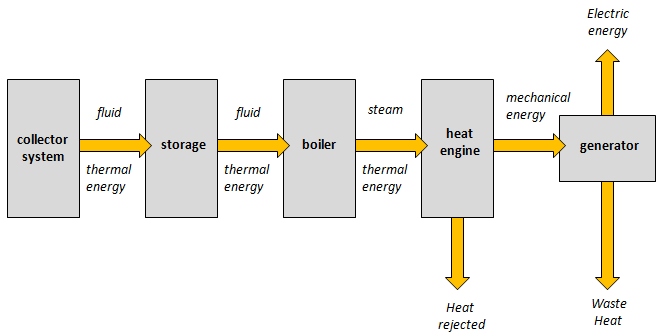Steam has been used for centuries to perform mechanical work. Steam locomotive engines are probably one of the most popular machines known for converting steam to mechanical work. Any modern steam turbine does a similar conversion at higher energy conversion efficiency. Many steam turbines are used because of their high efficiency at turning steam energy into kinetic rotational energy. This rotational energy can be further used to drive an electricity generator or any other process that requires mechanical energy to operate. Historically, the steam required for such processes was derived from burning fossil fuels such as coal or natural gas, while solar thermal energy was used experimentally for over a century. Steam that is generated by renewable methods (such as solar radiation) is identical to steam generated by burning a fuel to heat water, and the principles of conversion of solar heat to mechanical and electrical energy are fundamentally similar to those used in combustion systems. Concentrating solar thermal technologies are best suited to achieve high temperatures under higher pressures, simultaneously meeting the demands of large-scale turbines that require a significant amount of high-quality steam. The general strategy of energy conversion using solar thermal energy is presented on the diagram below.

The solar energy obtained and converted to heat by the collector system is transferred by the thermal fluid to the storage and further to a boiler, where steam is generated. Further steam is supplied to a turbine in the heat engine, where it is converted to mechanical energy, while some heat is rejected. If the electric power is desirable output, the mechanical energy is supplied to a generator, where it is converted to electricity. At each conversion step, we can expect some losses due to non-100% efficiency. One of the challenges here is that the efficiency of the solar collectors decreases with increasing operating temperature, while the efficiency of the heat engine increases at a higher temperature (Duffie and Beckman, 2013). Therefore optimization is needed to select system operation conditions. Typically the temperatures delivered by the flat-plate collectors are too low for heat engines to be efficient; thus concentrating collectors (e.g. parabolic systems) or evacuated tubular collectors are more preferable choices.
The main configurations of solar thermal power systems include:
- Parabolic troughs
- Parabolic dish
- Central receiver systems (power tower)
- Solar updraft tower
You can re-visit those technologies on the Energy Information Association website
The overall efficiency of the power conversion system is composed of the efficiency of the solar collectors (with parabolic troughs, max ~75%), the efficiency of the heat engine (~35%). Minus field losses, the typical average overall efficiency of solar trough thermal plants is around 15-20%.
The following pages of this lesson refer you to various types and system designs.
